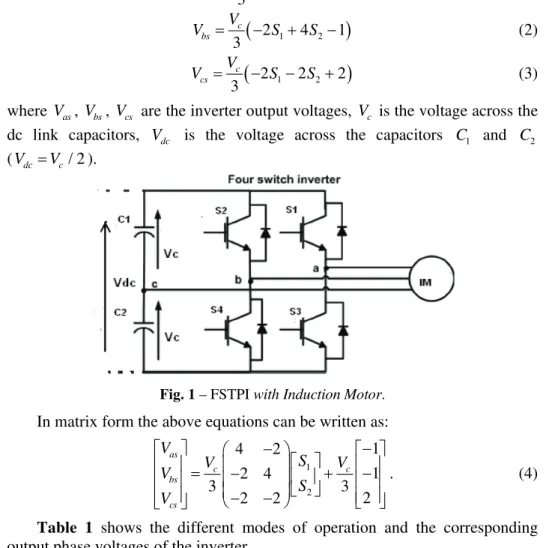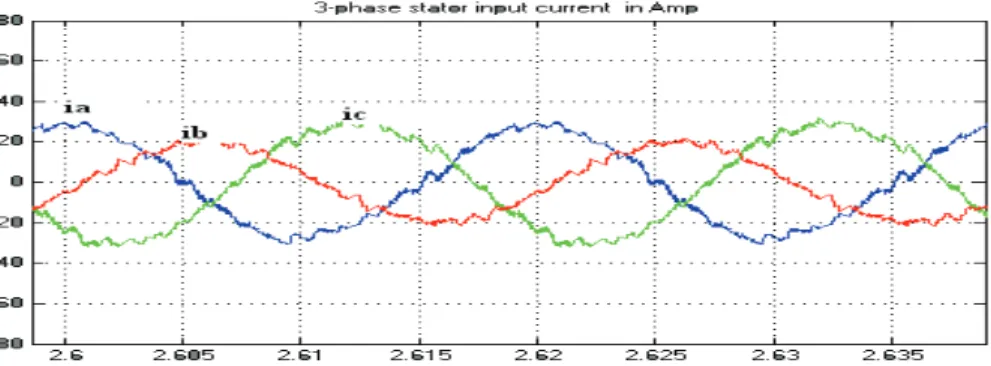Vol. 7, No. 2, November 2010, 195-204
Microcontroller Based PWM Controlled
Four Switch Three Phase Inverter Fed
Induction Motor Drive
Nalin Kant Mohanty
1, Ranganath Muthu
2Abstract: This paper presents PIC microcontroller based PWM inverter controlled four switch three phase inverter (FSTPI) fed Induction Motor drive. The advantage of this inverter that uses of 4 switches instead of conventional 6 switches is lesser switching losses, lower electromagnetic interference (EMI), less complexity of control algorithms and reduced interface circuits. Simulation and experimental work are carried out and results presented to demonstrate the feasibility of the proposed approach. Simulation is carried out using MATLAB SIMULINK and in the experimental work a prototype model is built to verify the simulation results. PIC microcontroller (PIC 16F877A) is used to generate the PWM pulses for FSTPI to drive the 0.5 hp 3-phase Induction Motor.
Keywords: Four Switch Three Phase Inverter (FSTPI), Induction Motor (IM), Pulse Width Modulation (PWM), Total Harmonic Distortion (THD), Peripheral Interface Controller (PIC).
1 Introduction
Induction motors are being used for many industrial and commercial applications because it its easy build, high robustness, and generally satisfactory efficiency. AC induction motors, which contain a cage, are very popular in variable-speed drives. They are simple, rugged, inexpensive and available at all power ratings. Progress in the field of power electronics and microelectronics enable the application of induction motors for high-performance drives. The speed of the induction motor can be controlled by varying its input AC voltage and frequency using an Inverter.
A standard six - switch three phase voltage source inverter has six switches in three legs with a pair of complementary power switches per phase. A reduced switch count voltage source inverter i.e. four switch three-phase inverter
1
Department of Electrical and Electronics Engineering, Anna University, Chennai 600025, India; E-mail: nkmohanty2003@yahoo.co.in
2
(FSTPI)] uses only two legs, with four switches. The advantage of this inverter due to the use of 4 switches instead of conventional 6 switches is lesser switching losses, lower electromagnetic interference (EMI), less complexity of control algorithms and reduced interface circuits. Several articles report on FSTPI structure [1-5].
In recent years, with the increasing use of microcontrollers in power electronics, it becomes possible to use it to generate the pulse width modulation (PWM) signals to control the speed of the induction motor. The microcontroller provides the variable frequency signal that controls the applied voltage on the gate drive, which provides the required PWM frequency at the output of the power inverter. Low cost PIC16F877A microcontroller has been chosen for implementation for ease in development and fast response. In addition, PIC16F877A has high-performance RISC CPU with only 35 single-word instructions, all single-cycle instructions except for program branches, which are two-cycles, and operating speed of 20 MHz.
2 Proposed
Topology
In the simulation and experimental work, the single phase half bridge rectifier converts AC power to DC. The DC power is fed to FSTPI. The FSTPI converts the DC power to controlled 3-phase AC power. The 3-phase induction motor is driven by the FSTPI. PIC microcontroller 16f877A is used to generate the controlled PWM pulse for FSTPI. The controlled PWM pulses of microcontroller are fed to the gate of MOSFETs of FSTPI through the driver circuit to drive the IM.
2.1 Principle of FSTPI operation
The power circuit of the FSTPI fed IM drive is shown in Fig. 1. The circuit consists of 4-switches S1, S2, S3 and S4 and split capacitors C1 and C2. The 3-phase AC input, which is of fixed frequency, is rectified by the rectifier switches. The power circuit is the three-phase four-switch inverter. Two phases ‘a’ and ‘b’ are connected to the two legs of the inverter, while the third phase ‘c’ is connected to the center point of the dc-link capacitors, C1 and C2.
The 4 power switches are denoted by the binary variables S1 to S4, where
the binary ‘1’ corresponds to an ON state and the binary ‘0’ corresponds to an OFF state. The states of the upper switches (S1,S2) and lower switches (S3,S4) of a leg are complementary that is S3= −1 S1 and S4= −1 S2. The terminal
(
4 1 2 2 1)
3c as
V
V = S − S − (1)
(
2 1 4 2 1)
3 c bs
V
V = − S + S − (2)
(
2 1 2 2 2)
3 c cs
V
V = − S − S + (3)
where Vas, Vbs, Vcs are the inverter output voltages, Vc is the voltage across the dc link capacitors, Vdc is the voltage across the capacitors C1 and C2
(Vdc =Vc/ 2).
Fig. 1 – FSTPI with Induction Motor. In matrix form the above equations can be written as:
1 2 1 4 2 1 2 4 3 3 2 2 2 as c c bs cs V S V V V S V − − ⎡ ⎤ ⎛ ⎞ ⎡ ⎤ ⎡ ⎤ ⎢ ⎥= ⎜− ⎟ + ⎢ ⎥− ⎢ ⎥ ⎢ ⎥ ⎜ ⎟⎣ ⎦ ⎢ ⎥ ⎜ ⎟ ⎢ ⎥ ⎝− − ⎠ ⎢ ⎥⎣ ⎦ ⎣ ⎦ . (4)
Table 1 shows the different modes of operation and the corresponding output phase voltages of the inverter.
Table 1
Switching states and output phase voltages.
Switching states Output voltages
S1 S2 Vas Vbs Vcs
0 0 −Vc / 3 −Vc / 3 2Vc/ 3
0 1 −Vc Vc 0
1 0 Vc −Vc 0
2.2 PWM generation in PIC microcontroller
8-bit PIC16F877A microcontroller was chosen to obtain the pulses for the FSTPI to drive the Induction Motor. This Microcontroller has a 25 MHz processor, 33 input/output (I/O) pins, interrupts, counters, timers, I/O ports, RAM, and ROM/EPROM. The peripheral interface controllers (PICs) are the integrated circuits based on CMOS technology. The main components of a PIC are RAM, EPROM, EEPROM, and Peripheral Interface Adaptor (PIA). These components are inserted in the same integrated circuit to reduce the size, the cost of the system and make design of the system easier. The address bus, the data bus and the control bus connecting the components are placed in the PIC circuit by the manufacturer. Because of these advantages, PICs have been preferred devices in practical control applications. PIC16F877A used in this work operates at 20 MHz clock frequency and runs each instruction as fast as 200 ns. Flash Program Memory is up to 8K×14 words. Data memory is partitioned into four banks which contain the General Purpose Registers and the Special Function Registers. Bits RP1 and RP0 are the bank select bits. Each bank extends up to 7Fh (128 bytes). It contains 1 K EEPROM as a program memory, 15 special hardware registers, 36 general purpose registers and 64 byte EEPROM as a data memory. PICs have been preferred control devices because of their low cost, less energy consumption and small volume.
The microcontroller has been programmed to vary the frequency of the PWM signal that controls the frequency of the voltage applied at the gate drives, and as a result of this the switching frequency of the inverter is controlled.
3
Simulation Work and Results
Digital computer simulation model using MATLAB-SIMULINK has been developed to test the proposed FSTPI fed IM drive block as shown in Fig. 2. Simulation circuit diagram of the system is shown in Fig. 3. The FSTPI fed drive system consists of a three-phase diode bridge rectifier, a split capacitor, four switch three phase inverter and 3-phase squirrel cage Induction Motor.
•Input three-phase supply voltage: 400 V (rms), 50 Hz;
•Three-phase induction motor: 3 hp, 400 V, 50 Hz, 1500 rpm.
Fig. 2 – Simulink block diagram of FSTPI fed drive system.
Fig. 3 – Complete Simulation Circuit diagram of FSTPI fed IM Drive system.
Fig. 5 – Rotor speed in rpm vs. time in s and Electromagnetic torque in Nm vs. time in s without Load.
Fig. 6 – Rotor speed in rpm vs time in s and
Electromagnetic torque in Nm vs time in s with 10 Nm Load.
Fig. 8 – THD with load for phase current ia.
4
Experimental Work and Results
4.1 Software implementation
In the experimental work, source code is written in the C language using MPLAB’s inbuilt text editor. The source file is then compiled by invoking the PCB or PCM compiler in the MPLAB window. The code was tested using MPLAB’s simulator. Finally the microcontroller is placed in the PICSTART programmer and programmed.
4.2 System hardware design
The completeprototype of the experimental setup is shown in Fig. 9. The details of the components used in this experiment are given in Table 2. The potential transformer is used to provide the power to PIC microcontroller board and driver circuit board. A single phase diode bridge rectifier and filter circuit is used to convert AC to DC. Four MOSFETs and 2-split capacitors are used to form FSTPI. The output of FSTPI is connected to the 0.5 hp 3-phase Induction Motor. Oscilloscope is used to display the PWM pulses and the output current waveform of ia.
Table 2
Hardware components.
Components Ratings
Capacitor 1000 μf, 250v
Inverter MOSFET (IRF 460)
Induction Motor 0.5 hp, 3-phase, 50Hz, 400v, 1430 rpm
Microcontroller 16F877A
Rectifier 110 V, 5 A, Single phase Bridge Rectifier
frequency is configurable within the range 20Hz – 2 kHz and the duty cycle can be varied from 0% to 100%. The PWM signals of the MCU are applied to the gate of MOSFET through gate driver circuit. The gate driver provides isolation, low impedance and high current supply to drive the MOSFET. By controlling the input voltage to the analog ADC, the output frequency of the Microcontroller can be controlled.
Fig. 9 – Complete hardware setup of PIC microcontroller based FSTPI fed IM Drive.
4.3 Experimental results
The experimental results obtained are shown in Figs. 10-12. Figs. 10 and 11 show the controlled output PWM pulses of MCU for switches S1 and S2, with adjustable pulse width and frequency. Pulses of S3 and S4 are similar but reverse of S1 and S2. The output current ia of the single phase system fed to an induction motor is shown in Fig. 12.
Fig.11 – Pulses to switchS2.
Fig. 12 – Output current ia of FSTPI with IM.
5 Conclusion
A PIC microcontroller based PWM controlled FSTPI fed Induction Motor drive has been designed and implemented successfully. The simulation and hardware implementation results are presented to verify the feasibility of the system. The implementation of the proposed work shows the practical industrial application FSTPI.
6 References
[1] J. Kim, J. Hong, K. Nam: A Current Distortion Compensation Scheme for Four-switch Inverters, IEEE Transactions on Power Electronics, Vol. 24, No. 4, April 2009, pp. 1032 – 1040. [2] M.B.R. Correa, C.B. Jacobina, E.R.C. Silva, A.M.N. Lima: A General PWM Strategy for
Four-switch Three-phase Inverters, IEEE Transactions on Power Electronics, Vol. 21, No. 6, Nov. 2006, pp. 1618 – 1627.
[3] M.N. Uddin, T.S. Radwan, M.A. Rahman: Fuzzy-logic-controller-based Cost-effective Four-switch Three-phase Inverter-fed IPM Synchronous Motor Drive System, IEEE Transaction on Industry Application, Vol. 42, No.1, Jan/Feb. 2006, pp. 21 – 30.
[5] F. Blaabjerg, D.O. Neacsu, J.K. Pedersen: Adaptive SVM to Compensate DC-link Voltage Ripple for Four-switch Three-phase Voltage-source Inverters, IEEE Transactions on Power Electronics, Vol. 14, No. 4, July 1999, pp.743 – 752.
[6] Microchip Technology, 2001, PIC16F877A Data sheet, www.microchip.com.
[7] M. Vasudevan, R. Arumugam, S. Paramasivam: High-performance Adaptive Intelligent Direct Torque Control Schemes for Induction Motor Drives, Serbian Journal of Electrical Engineering, Vol. 2, No. 1, May 2005, pp.93 – 116.
[8] M. Bounadja, A. Mellakhi, B. Belmadani: A High Performance PWM Inverter Voltage-fed Induction Machines Drive with an Alternative Strategy for Speed Control, Serbian Journal of Electrical Engineering, Vol. 4, No. 1, June 2007, pp.35 – 49.
[9] K. Rathnakannan, V. Ranjan: The Modeling and the Analysis of Control Logic for a Digital PWM Controller based on a Nano Electronic Single Electronic Transistor, Serbian Journal of Electrical Engineering Vol. 5, No. 2, Nov. 2008, 285 – 304.





